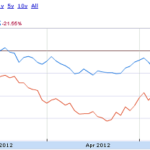The risk trade is on. Investors sitting idly by on the sidelines watching everyone else make 70-100% since the March lows are resolved to the fact that risk-free investment returns are going to be negative in terms of even modest inflation for years to come. As such, investors in the income arena are increasingly shifting funds from safer bets like Treasuries and Money Markets into higher risk assets that actually delivery meaningful yield.
Last month, two high yield ETFs in particular saw massive investor inflows. SPDR Barclays Capital High Yield Bond (JNK) and iShares iBoxx $ High Yield Corporate Bond (HYG) each saw inflows in excess of $400 Million in March. Starting in 2008 and into 2009, high yield corporate bonds (otherwise known as junk bonds) saw huge drops in price under the premise the America was going to see a massive wave of corporate defaults, the likes of which we hadn’t seen since the Great Depression. While the current economy wouldn’t be considered “strong” by any stretch of the imagination, the Armageddon scenario envisioned just a year ago never came to fruition.
It’s understandable that investors are hesitant to pick individual high yield bond issues and invest given solvency risk of any one particular company in conjunction with the hassle and minimum investment requirements many of them entail. However, both JNK and HYG offer a very diverse mix of corporations in various sectors. So, investors are now availed to both diversification and a yield of 9-11%, which is paid monthly instead of quarterly.
The question is when the music stops. It stands to reason that if and when the Fed eventually starts raising rates, income investments will begin to appear to be less attractive and these ETFs could see declines. Additionally, if a new wave of corporate defaults does occur unexpectedly, it’s highly likely that many of those issues will be within these portfolios.
For perspective, while these ETFs offer spectacular yields, the share price returns have trailed stocks during the recovery. Investors savvy enough to brave equities over the past year realized a return of 44% in the S&P500 (SPY) and 59% in Emerging Markets (EEM) vs. 31% in JNK and 24% in HYG. Add ~10% to JNK and HYG to account for the yield spread over EEM and SPY. If the uber-risk trade remains, it’s likely that equities will continue to outperform; note that a hybrid investment in Preferred Stock ETFs has performed exceptionally well of late as well – with both capital appreciation and high yield. However, if you believe stocks may have a breather in store and trade sideways for a while, either of these ETFs may provide a nice parking spot for the income portion of your portfolio.
Disclosure: Long HYG in self-directed IRA account. Currently hedging portfolio with an SPY Put Spread in Taxable Trading Account. No other holdings in aforementioned ETFs.











{ 0 comments… add one now }